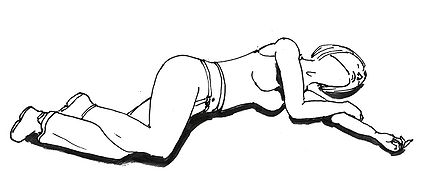Stable side position
The stable side position is the standard position of a consciously impaired or unconscious person breathing independently as part of the emergency life-saving measures . While the life-saving handle initially clears the airways , the stable side position also serves the purpose of preventing accidental inhalation of liquids and solids such as saliva, blood and vomit . This aspect is essential, since the unconscious often vomits unnoticed and as a result often suffocates on their vomit .
It is important for first aid that the person at risk breathes independently. In the case of persons who do not breathe spontaneously, do not lie on their side, but rather resuscitate .
The stable side position is also used when spinal injuries are suspected, as the risk of death from suffocation due to possible obstructions of the airways is rated higher than the risk of further damage to the spine.
variants
There are different international versions of the stable side position that have specific advantages and disadvantages. Common features are a stable position on the side, hyperextended head and no pressure on the chest that interferes with breathing. In addition to overstretching the head, the most important goal is that the mouth is the lowest point of the body and that vomit cannot run into the airways.
application
A motionless person is first on his back supported to check consciousness and breathing ( Diagnostic block ), this is usually why the starting point for further measures. If the person concerned breathes independently in spite of the disturbed consciousness, he is brought into the stable side position. To protect against the weather, it is then preferably wrapped in a rescue blanket in order to avoid cooling down or overheating . Until the arrival of my emergency alerted rescue services the person is constantly monitored. In this way, if the condition worsens, further measures can be initiated in good time and those affected can be reassured. The stable side position is also essential in the rescue service, as it is the simplest and most efficient method of securing the airway.
If the person concerned has an injury to the chest or lungs , they are turned to the injured side so that the unimpaired half of the lung , which is then on top, can freely unfold during inhalation and any bleeding can be squeezed off .
Pregnant women tend to be positioned on their left side, as this is the best way to relieve the common circulation of mother and fetus (see Vena cava compression syndrome ).
criticism
Occasionally, individual people criticize the stable side position as superfluous and doubt their “strictly scientifically based evidence”. One study showed that subjects were significantly less likely to recognize respiratory arrest in patients who were placed in a stable lateral position compared to those who were on their back. This could delay the necessary cardiopulmonary resuscitation or not initiate at all.
Web links
- Illustrated instructions from the DRK to bring you to the simplified form of the stable side position
- Current guidelines of the ERC on emergency life-saving measures for adults (PDF; 145 kB)
Individual evidence
- ^ AJ Handley: Recovery position. In: Resuscitation. 26 (1), Aug 1993, pp. 93-95. PMID 8210737
- ↑ AJ Handley, R. Koster, K. Monsieurs et al: European Resuscitation Council guidelines for resuscitation 2005. Section 2. Adult basic life support and use of automated external defibrillators. In: Resuscitation. 67 Suppl 1, 2005, pp. S7-S23. PMID 16321717
- ↑ Martin U. Müller : You can't get more dead than dead. In: Spiegel online . April 9, 2008, accessed August 13, 2017 .
- ↑ Deutscher Ärzteverlag GmbH, editorial office of Deutsches Ärzteblatt: Stable lateral position: Not necessarily life-saving . ( aerzteblatt.de [accessed on August 13, 2017]).
- ↑ The myths of first aid: "You can't get more dead than dead". In: Spiegel online. Retrieved August 13, 2017 .
- ↑ Miguel Freire-Tellado, Rubén Navarro-Patón, Maria del Pilar Pavón-Prieto, Marta Fernández-López, Javier Mateos-Lorenzo: Does lying in the recovery position increase the likelihood of not delivering cardiopulmonary resuscitation? In: Resuscitation . tape 115 , June 1, 2017, ISSN 0300-9572 , p. 173–177 , doi : 10.1016 / j.resuscitation.2017.03.008 , PMID 28404450 ( resuscitationjournal.com [accessed August 13, 2017]).
